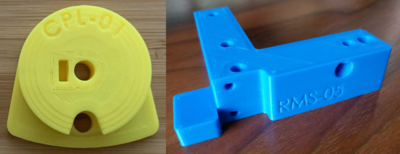Difference between revisions of "Part Numbers"
Poofjunior (talk | contribs) (Created page with "All of Jubilee’s “custom” parts are set to have part numbers. These are embedded in a shortened form in a discrete location on the part that is still visible when the pa...") |
Poofjunior (talk | contribs) |
||
| Line 1: | Line 1: | ||
All of Jubilee’s “custom” parts are set to have part numbers. These are embedded in a shortened form in a discrete location on the part that is still visible when the part is installed in the machine. | All of Jubilee’s “custom” parts are set to have part numbers. These are embedded in a shortened form in a discrete location on the part that is still visible when the part is installed in the machine. | ||
| − | [[File:Embedded Part Numbers.png|400px| | + | [[File:Embedded Part Numbers.png|400px|thumbnail]] |
== Why Part Numbers? == | == Why Part Numbers? == | ||
Revision as of 22:19, 7 May 2020
All of Jubilee’s “custom” parts are set to have part numbers. These are embedded in a shortened form in a discrete location on the part that is still visible when the part is installed in the machine.
Why Part Numbers?
Part numbers are a way for the community of Jubilee builders to communicate both with each other and with external vendors and to keep track of differences in physical machines against the latest Jubilee design revision.
- Tracking Versions. Jubilee’s design changes occasionally. Having a part numbering scheme and embedding those number on the parts themselves is a way for people to identify what version of what part is physically installed on their machine compared to what’s online. Part numbers offer clarity to the builder.
- Specificity. Jubilee’s parts are manufactured and sold by a variety of parties. Having part numbers stamped on these parts helps Jubilee builders understand where their parts came from and whether or not there are differences between vendors. As the project builds a relationship with manufacturers, Jubilee builders will be able to request machined parts by a specifying the part number. Finally, Jubilee has a variety of alternate/upgraded parts. If Jubilee builders are troubleshooting issues with their machine, folks in the community can get a sense of “what version” of Jubilee is having this issue by asking for part numbers.
- Part Configurability. Some of Jubilee’s 3D-modeled parts (like the tool posts) are parametric and have a variety of configurations. Giving these configurations unique part numbers helps Jubilee builders identify exactly what configuration of a part they have.
Part Numbering Scheme
The part numbering scheme is as follows:
[subassembly] - [part id + params] - [revision] - [fab process + material] - [who fabricated it]
For 3D printed parts, only the short numbering scheme will be embedded on the part.
[subassembly] - [part id + params] - [revision]
Here are a couple examples: * 041-CRS-02-M61-MRW * Is the aluminum crossbar from the alternate crossbar subassembly in the design’s second revision and machined from 6061 aluminum, and manufactured by Mandala Rose Works.
Here’s the breakdown of what these mean.
- [subassembly] what lowest-level subassembly does this belong to? This subassembly should also have a set of instructions.
- 00 top level assembly
- 01 Outer Frame Assembly
- 02 Default Motor Plate Assembly
- 03 Double Pulley Corner Plate Assembly
- 031 Aluminum Double Pulley Corner Plate Assembly
- 04 Default Crossbar Assembly
- 041 Aluminum Crossbar Assembly
- 05 toolchanger elastic lock assembly
- 06 toolchanger carriage component assembly
- 07 Magnetic Build Plate Assembly
- 08 Duet2 Electronics Back Panel Assembly
- 081 Duet3 Electronics Back Panel Assembly
- 09 Side Panels Assembly
- 10 Lower Frame Assembly
- 11 CoreXY Frame Assembly
- 12 Z axis assembly
- 13 Tool Holder Assembly
- 14 Extruder-Based Tools and Additions
- [part id + params] 3-9 characters. (Uppercase) letters and numbers only. Try to keep these around 3 characters while the rest are reserved for parameters. Here are some common ones.
- EXT409 – extrusion of length 409mm
- CRS – crossbar
- BED – bed plate
- [revision] two digits increasing from 0
- [fab process + material]
- Machined
- 6061 aluminum
- K100S aluminum cast tool plate
- MIC6 aluminum cast tool plate
- ATP5 aluminum cast tool plate
- 3DPrinted
- PLA
- PETG
- Carbon Fiber impregnated PLA
- Carbon Fiber impregnated PETG
- Other materials will get numbers or letters, depending on what’s left.
- Laser cut
- Machined
- [who fabricated it] This can be an open field in the scheme that can be used by the machinist. Otherwise, here are some defaults.
- MiSUmi
- 713Maker
- SeeMeCNC
- Mandala Rose Works
Extra Rules
- Let’s not use the letters I and O as they can be confused with numbers
- All letters should be capitalized
Using Part Numbers
Part numbers can be useful! Part numbers are set to be embedded on 3D printed parts in the next few weeks. The location of this embedding should be in a place where you can read it after it’s been installed on the machine. The result is that you can cross-reference your exact version of a part with any future versions to see if you need improvements. We can also troubleshoot on the Discord Server discussing problems related to your exact part models.
